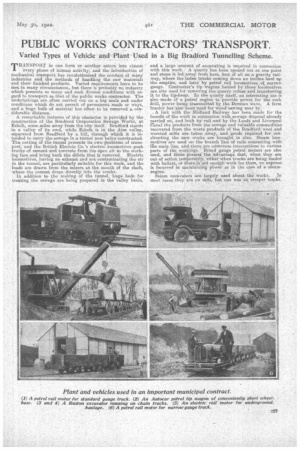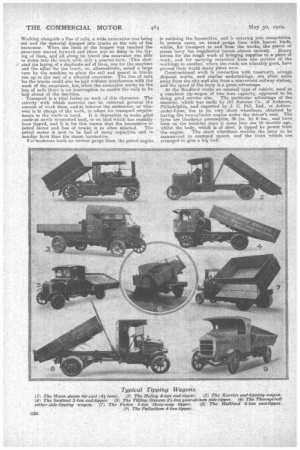PUBLIC WORKS CONTRACTORS' TRANSPORT.
Page 21

Page 22

If you've noticed an error in this article please click here to report it so we can fix it.
Varied Types of Vehicle'and.flant 'Used
in a Big Bradford Tunnelling Scheme. .
TRANSPORT in one form Or another enters" into althost '
• .every phase of human activity and the iiiirtiducticirt of mechanical transport has revolutionized the conduct 61 many industries and the methods of handling the raw Materials and their finished products. Varied requitements have to be met in many circumstances, but there is probably no industry which presents so many and such diverse conditions with regard to transport as that of the public works contractor. The undertakings are often carried out on a big scale and under conditions which do not permit of permanent roads or Ways, and .a huge bulk of material has often. to be removed a .censiclerable distance.
A. remarkable instance of this character is prbvided by the construction of the Bradford Corporation Sewage WorkS, Esholt, some miles away from the city itself. Bradford stands in a valley of its owd, while Esholt is in the Aire separated from Bradford by a hill, through which it is intended to carry the sewage in a tunnel now beirirt constructed. The cutting of the tunnel preserits its own .firoblems of transport and the British Electric Co.'s electric locomotives push truclns of cement and concrete from the open air to the working face and bring back the debris that is removed. Electric locomotives, having no exhaust and not contaminating the air in the tunnel, are particularly suitable for this work, and the loads are drawn from the mixers at the mouth of the shaft, where the cement drops directly into the trucks.
In addition to the making of the. taring, 'huge beds for treating the sewage are being prepared in the valley basin, and a large amount of excavating is required in connection with this work. A quarry has been opened out at one point and stone is led away from here, first of all on-a gravity railway, where the laden trucks coming down an incline haul up the empties, and later by petrol rail locomotives. of, narrow gauge. Contractor's tip wagons hauled by these locomotives are also used for removing the quarry refuse and transferring it to the tip-heap-. In the quarry itself, an interestinc, use is also •made of a petrol engine to provide power for the rock drill, power being transmitted by the Dorman wave. A farm tractor has'aLso been, used for woocksawina near by: A link with the Midland Railway has been made for the benefit of the work in connection with sewage disposal already carried on, and both by -rail -and by Cho Leeds and Liverpool canal the products from the sewage and valuable commodities recovered from the waste products Of the Bradford wool and worsted mills are taken away, and goods required for constructing the new works are brought in also. Steam locomotives are used on the branch line of rails connecting with file main line, and there are itilmerous intersections to various parts of the workings. Broad gauge petrol motors are also used and these possess the advantage that., when they are out of action t•eniporarily,:either when trucks are being loaded with ballast; or there.iS'net enough work for them, no expense is incurred in. maintainingpOwer. as in the case of a steam
engine. . . • .
Steam excavators are largely used about the works. In most cases they are .on risis, but OLIO waS On creeper tracks.
Working alongside a line of rails, a wide excavation was being cut and the material dumped into trucks at the side of the excavator. When the limit of the hopper was reached the excavator moved forward and there was no delay in the laying of lines, and all along. its travel the excavator was able to dump into the truck with only a quarter-turn. 'This atedthe laying of a duplicate set of lines, one for the machine and the other for the truck, or, alternatively, saved a large turn by the machine to place the soil and gravel in trucks run up to the rear of a wheeled excavator. The line of rails for the trucks could also be laid without interference with the work of the excavator, but, when the excavator works on the line of rails there is an interruption to enable the rails to be laid ahead of the machine.
Transport is a vital factor on work of this character. The celerity with which material can be removed governs the amount of work done, and it behoves the contractor; or whoever is in charge of the work, to adapt his transport requirements to the worloin hand. It is impossible to make gOod made on newly excavated land, or on land which has recently been tipped, and it is for this reason that the locomotive or petrol motor and line of trucks is so often selected. The petrol motor is now to be had of many capacities and in handier form than the steam. locomotive.
For'moderate loads on narrow gauge lines, the petrol engine
is outdoing the locomotive, and is entering into competition, in certain cases, on broad gauge lines with heaver loads, whilst, for transport to and from the works, the petrol or steam lorry has supplanted horses almost entirely. Heavy lorries for the rough work of bringing supplies to a piece of work, and for carrying materials from one portion of the workings to another, where the roads are tolerably good, have proved their worth many limes over. Constructional work in connection with reservoirs, sewage disposal works, and similar undertakings, ate often miles. away from the city and also from a convenient railway station, and the speed of the lorry is a great advantage. At the Bradford works an unusual type of vehicle used as a runabout tip-wagon of two tons capacity, appeared to be
dbing good service also. The particular advantage of the machine, which was ma& by the Autocar Co., of Ardmore, Philadelphia, and imported by J. C. Fell. Ltd., of Ashtonunder-Lyne, lies in its very short wheelbase, obtained by having the two-cylinder engine under the driver's seat. The tyres are Goodyear pneumatics, 36 ins. by 6 ins., and have been on the machine since it Came into use 16 months ago, whilst the body, which is of steel, is tipped by power from the •engine. The short wheelbase enables the lorry to be manceuvred in cramped spaces, and the front wheels are. arranged to give a big lock.












































